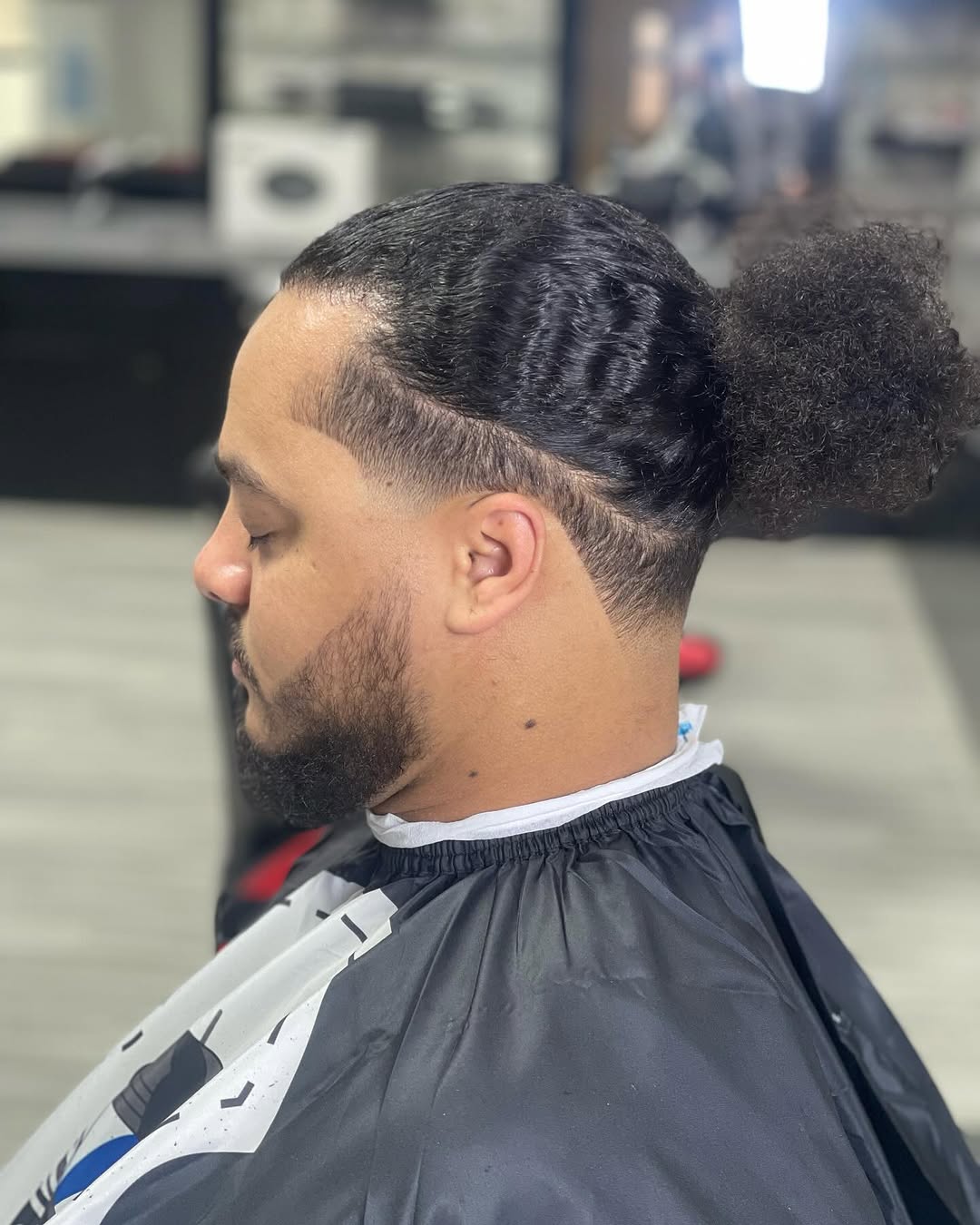The Low Taper Fade - Unraveling Its Origins
The low taper fade, a hairstyle that truly defines a clean and sharp look, has become quite the staple in barbershops and salons all over the place. It's a style that, you know, just seems to fit so many different people, offering a really neat blend of classic and modern vibes. You see it everywhere, on folks from all walks of life, and it just has this way of making a statement without being overly dramatic. It’s a very popular choice, and it’s almost like it appeared out of nowhere to become this widely loved thing, isn’t it?
When something like the low taper fade becomes so incredibly widespread, people naturally start to wonder, you know, who actually came up with it? It’s a pretty common question for any popular cultural item, whether it's a new way of listening to music, or maybe a certain kind of food that suddenly becomes the talk of the town. Yet, it’s often the case that pinning down a single person or a precise moment for these kinds of creations can be, well, a bit tricky. It’s not always like there’s one inventor, standing there with a lightbulb moment, yelling, “Eureka!”
So, instead of trying to find that one specific individual who might have first imagined the low taper fade, we can, in a way, think about how these sorts of trends actually gain a foothold. We can look at the broader picture of how styles evolve, how they get picked up, and how they then spread like wildfire through communities. It’s a fascinating process, really, and it tells us a lot about how people interact with new looks and make them their own. This exploration, you know, helps us appreciate the journey of a style, rather than just focusing on a single starting point, which is that, perhaps, a more interesting story.
- Is Lady Gaga Alive
- Shockers Sour Candy
- Patrick Bet David Bio
- Download Pmvhaven Videos
- Clint Eastwood As A Child
Table of Contents
- The Allure of the Low Taper Fade
- Where Does a Look Like the Low Taper Fade Even Come From?
- The Elusive Nature of Style Creation
- Could One Person Really Invent the Low Taper Fade?
- How Trends Take Hold – Beyond a Single Creator
- What Makes a Style Like the Low Taper Fade Spread So Quickly?
- Echoes of Other Cultural Spreads
- Is the Story of the Low Taper Fade Similar to How Other Things Become Popular?
The Allure of the Low Taper Fade
The low taper fade, you know, has this really compelling appeal. It’s about the way the hair gradually gets shorter down to the skin, just above the ear and around the nape of the neck. This creates a very neat, polished edge, which can make someone’s overall appearance seem a lot more put together. It’s a bit of a chameleon, too, in that it can be dressed up or down, fitting in with a sharp suit just as easily as it does with casual wear. This adaptability, I mean, is a big part of why it has become so well-liked by so many people, truly. It offers a kind of understated elegance that is, frankly, pretty hard to argue with.
People are drawn to its clean lines and the way it frames the face, giving a distinct shape without being too drastic. It’s a style that tends to be quite flattering for a lot of different face shapes, which is, obviously, a huge plus. The low taper fade also provides a sort of blank canvas on top, allowing for various lengths and textures, from short crops to longer, flowing styles. This flexibility means that while the fade itself is consistent, the overall look can be very much personalized. It’s almost like, you know, it offers a structure that lets individual expression shine through, which is why it’s so widely adopted.
The visual impact of the low taper fade is, well, pretty immediate. It conveys a sense of attention to detail and a certain contemporary flair. You can see how it just sort of, you know, elevates a person's look without being over the top. It’s a style that communicates a sense of being current and well-groomed, which are qualities many people seek in their personal presentation. And, as a matter of fact, its popularity seems to keep growing, showing that it really has hit a sweet spot in what people are looking for in a modern haircut.
Where Does a Look Like the Low Taper Fade Even Come From?
When we ask, “Where does a look like the low taper fade even come from?”, it’s a question that, in some respects, points to a broader mystery about how cultural things begin. Think about it: very few styles, whether in fashion, music, or even how we eat, just appear out of thin air. They usually evolve, perhaps taking bits and pieces from older looks, or maybe they’re a fresh take on something that was once popular. So, to pinpoint the exact moment or the single person who invented the low taper fade, is that really possible? It’s often more of a gradual unfolding.
It’s a bit like trying to figure out who invented, say, the concept of having cold drinks available in restaurants, or even the idea of a specific type of music becoming a hit. These things don’t typically have one sole creator; rather, they are born from many different influences and small, individual experiments. Someone might try a slightly different cut, another person might adapt it, and then someone else sees it and thinks, “Hey, that looks good!” This kind of organic spread is, you know, how many styles really get their start. It’s a collective effort, more or less, even if no one intends it to be.
So, the low taper fade probably didn’t just pop into existence one day in a single barber’s chair. It’s more likely a result of barbers and stylists over time experimenting with different lengths and transitions, perhaps influenced by military cuts, or maybe even older urban styles. They might have been trying to create something that looked cleaner, or something that grew out more gracefully. This kind of tinkering, you know, happens all the time in creative fields. And then, at some point, a particular combination, like the low taper fade, just sort of clicked with people and started to catch on, becoming what it is today.
The Elusive Nature of Style Creation
The creation of a popular style, like the low taper fade, is often quite elusive to trace back to one specific source. It’s not like, say, an invention with a patent number or a clear historical record. Hairstyles, much like slang words or even certain dance moves, tend to emerge from a blend of influences, often in various places at the same time. Many people, you know, are experimenting, trying new things, and sometimes these individual efforts converge into a widely recognized trend. It’s a very organic process, which makes it hard to say, “This person, on this day, created it.”
You see, there are probably countless barbers and hair artists who have, at different times, cut hair in a way that closely resembles what we now call the low taper fade. They might have been working in different cities, perhaps even different countries, unaware of each other’s efforts. The idea, you know, could have been in the air, a natural progression of existing techniques. This kind of parallel development is actually pretty common in creative fields. It’s like how sometimes multiple musicians might come up with a similar sounding tune around the same time, or how different chefs might independently develop a similar dish. It’s just how things happen, sometimes.
Moreover, the naming of a style often happens after it has already gained some traction. Someone might have been doing a particular cut for years, and then, all of a sudden, a name like “low taper fade” gets attached to it, making it easier to talk about and ask for. This naming process itself can contribute to the elusiveness of its origin, because the style existed before it had its common label. So, you know, the very act of giving it a name helps it spread, but it doesn’t necessarily point to who invented the low taper fade in the first place, which is, frankly, quite interesting to consider.
Could One Person Really Invent the Low Taper Fade?
When we think about whether one person could really invent the low taper fade, it feels, honestly, a bit unlikely for a style that has become so universally recognized. Hairstyles, by their very nature, are often a blend of technique, personal preference, and cultural influence. It’s not like building a new type of device or writing a complex piece of software. It’s more about a gradual refinement and popularization of a particular aesthetic. So, to attribute it to a single individual seems, well, a little too simple for something so widespread.
Consider how many people are involved in the process of a haircut. There's the person getting the cut, the barber or stylist performing it, and then all the other people who see it and are inspired by it. Each of these interactions, you know, plays a part in a style's journey. If one person truly "invented" the low taper fade, how would that idea then travel across so many different places and become so widely adopted without some kind of massive, organized effort? It suggests a more organic, decentralized spread, where many hands, in a way, contributed to its popularity.
It’s more plausible that the low taper fade, like many other popular looks, is a result of many small contributions and adaptations over time. Someone might have perfected a certain technique for the taper, while another might have popularized the "low" aspect. And then, over time, these elements converged into the distinct style we recognize today. So, to say one person invented the low taper fade, is that really the right way to think about it? It’s probably more of a collaborative, evolving creation, driven by countless individuals, which is, you know, a pretty cool thought.
How Trends Take Hold – Beyond a Single Creator
Understanding how trends take hold, especially something like the low taper fade, really moves us beyond the idea of a single creator. It’s more about how a look gains momentum and then just keeps going, often through a kind of snowball effect. Think about how music videos can connect artists with fans on many different levels; a hairstyle, similarly, connects people through visual cues and shared aesthetics. Someone sees a look they like, they ask for it, and then others see it on them, and the cycle continues. This kind of visual inspiration is, actually, a very powerful force in spreading trends.
The spread often starts in specific communities or circles. Maybe it’s a group of friends, or people who frequent a particular type of establishment, like a certain barber shop or a club. From there, the style starts to move outward. People who are seen as trendsetters or influencers, even on a small scale, play a really big part. When they adopt a look, others are more likely to try it. It’s a very human thing, you know, to be influenced by what you see around you, especially from people you admire or relate to. This kind of social mirroring helps styles like the low taper fade really take off.
Then, of course, there’s the sheer accessibility and practicality of a style. The low taper fade is, in a way, relatively easy to maintain for many people, and it looks sharp without requiring too much fuss. This practical aspect helps it spread because it’s not just a fleeting, high-maintenance fashion statement. It’s something that can fit into daily life. So, when a style is both visually appealing and practical, it has a much better chance of becoming widely adopted, which is, in fact, a key part of how trends become pervasive in our culture.
What Makes a Style Like the Low Taper Fade Spread So Quickly?
So, what makes a style like the low taper fade spread so quickly? Well, for one thing, its visual impact is pretty immediate and clear. When you see someone with a well-done low taper fade, it just looks sharp and modern. This makes it easy for people to notice and, importantly, to ask for it. It’s not a subtle change; it’s a distinct look that catches the eye. This kind of clear visual identity helps a trend gain traction very, very fast because it’s easily recognizable and reproducible by skilled hands.
Another factor is the way people communicate about what they like. It’s like when you discover a new song or a really good place to eat, you want to tell your friends about it. Hairstyles are no different. Someone gets a great cut, their friends see it, they ask where they got it, and then they go get a similar one. This word-of-mouth, or rather, "word-of-look" spreading, is incredibly powerful. It's a very organic way for trends to move through a community, much like how a restaurant might get packed full of people on weekends because of positive buzz, you know?
The relatively simple concept behind the low taper fade also contributes to its quick spread. While it requires skill to execute well, the basic idea of a gradual shortening of hair is something that many barbers and stylists can grasp and adapt. This means it’s not limited to a very small, exclusive group of creators. Instead, it can be replicated across many different establishments, making it widely available. This widespread availability, honestly, is a huge driver of popularity, allowing the style to reach a vast number of people in a relatively short amount of time, which is, pretty much, how many popular things become common.
Echoes of Other Cultural Spreads
When we look at how the low taper fade gained its popularity, we can actually see echoes of how other cultural phenomena become widespread. It’s a bit like an anthropological or cultural study, if you will, of how different people react to something pervasive, like, say, the golden arches of a certain fast-food chain, or how a particular type of music becomes incredibly popular. There's a common thread in how things catch on, and it often has less to do with a single inventor and more to do with collective adoption and shared experiences. It’s a very human pattern of behavior, really.
Think about how music spreads, for example. An artist creates something, and then it connects with fans, perhaps through a platform that allows people to listen and share. The listening experience, in a way, becomes a shared journey. Similarly, with a hairstyle, someone creates a look, and then it resonates with people who see it, perhaps on someone they admire or just on a stranger walking by. That connection, that resonance, is what drives the adoption. It’s not just about the technical skill of the cut; it’s about the feeling or the identity it helps to create, which is, in fact, a very strong motivator for people.
Or consider how certain food items become staples in different regions. Back in the day, some places might not have had breakfast items readily available in certain types of restaurants, but then, over time, things changed, and those items became common. This kind of evolution and adaptation to what people want, or what they see as desirable, is a pretty consistent pattern across various cultural elements. The low taper fade, in a way, followed a similar path, adapting and spreading as more and more people found it appealing and useful for their own sense of style, which is, you know, quite a natural progression.
Is the Story of the Low Taper Fade Similar to How
- Mehr Iran Bank Loan Conditions
- Dirnt
- Clint Eastwood Children
- Mike Dirnt Wiki
- %D8%A8%D8%A7%D9%86%DA%A9 %D9%85%D9%87%D8%B1 %D8%A7%DB%8C%D8%B1%D8%A7%D9%86

10 Stylish Low Taper Fade Haircuts You Need To Try

Low Taper Fade Illustration | Stable Diffusion Online

Asian Low Taper Fade - Guo Charles